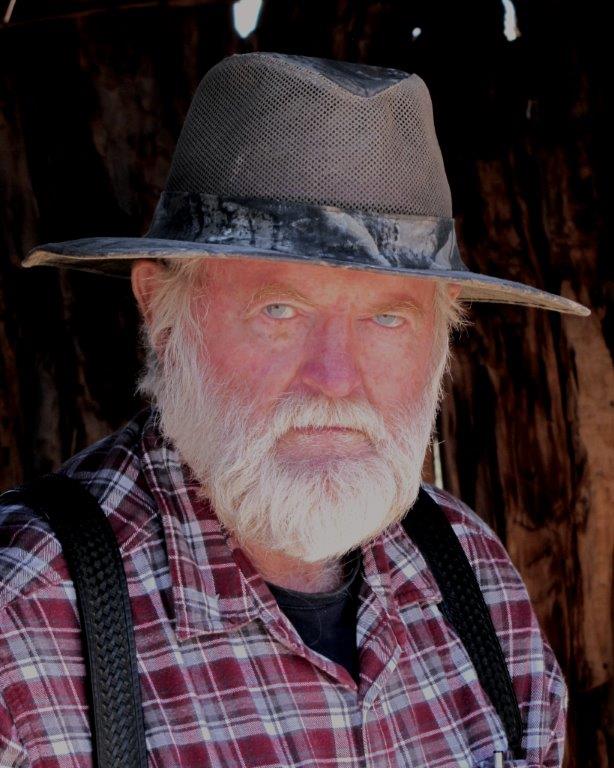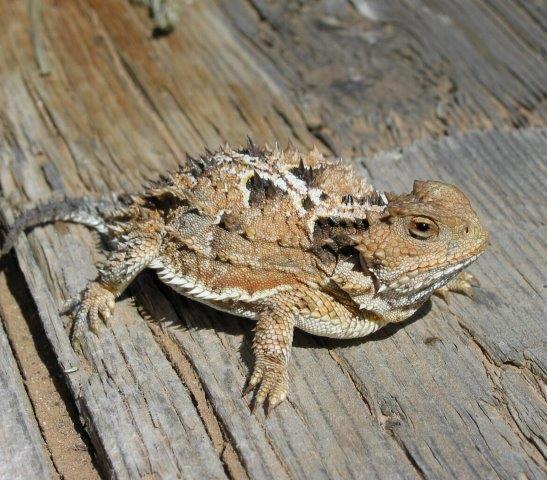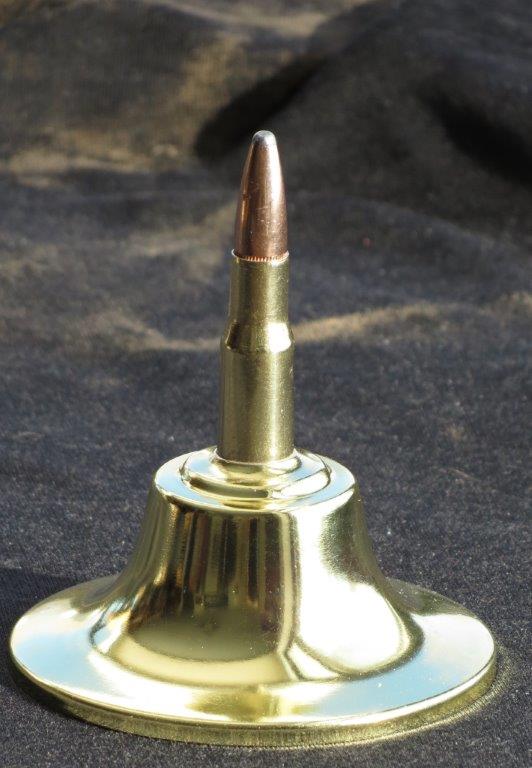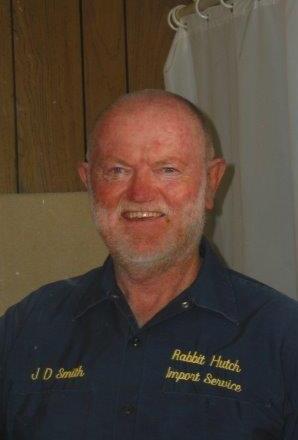
JD's History
Early Years
17 February 1942On a possibly miserable misty day (it was wintertime Arkansas), in a two-room log cabin built by one of my ancestors, my human experience began.

With the help of J. Boyd Smith, one of six paternal uncles, I returned to the cabin site while on Christmas leave in 1961 and photographed it. The cabin was in ruins but the picture preserves its appearance at the time.
Several very early memories are indelibly stamped in my mind. One of them, important to my entire life, was watching for my father who was scheduled to return, out of the army and return—to normal.
Unfortunately, the reason unknown to me until into the 21st century, he was never able to make it—to normal. He suffered PTSD in varying degrees until his death during his ninetieth year in 2008. He spent time in military and VA medical facilities but never recovered.
My brother Duane has suffered PTSD as a result of Vietnam service in the Marine Corps. In both cases the problem was guilt at having survived while others did not. For my brother it was an acutely close shave. His replacement arrived at Khe Sanh and while assuming duties as a front line wire communications specialist he also pre-empted Duane's customary eating perch on a shed roof. Before Duane shipped out his replacement was killed by mortar fire while eating, perched on that shed roof. Duane has been forced to deal with that for nearly fifty years. As Marine Corps Major General Smedley D. Butler titled the last chapter in his short book, War is a Racket: “To Hell With War.”
Following WWII Dad was unable to find satisfactory employment in Arkansas and traveled to Washington state where he had been employed before he enlisted in the army. He worked at Hanford Atomic Works during and after its construction. He returned to the Northwest, and was employed for seasonal work in 1946 at Larrabbee & Neff Orchards near Pateros, WA and was invited back for full-time employment.
In 1947 the family, which at the time included four children, rode the train North out of Springdale, Arkansas to near the Canadian border then West to Wenatchee, WA, the apple capital of the world. Dad Hired a taxi from Wenatchee to the Larrabbee orchards, a distance of 60 miles. He was employed in the fruit industry, with a few notable absences, in that industry for the rest of his life. The absences included some time in a VA hospital for “nerves”, and short stints in insurance and auto sales.
High School
I attended Pateros Public Schools 12 years in a single building (which might have fit into the dining area of Mitchell Hall) and graduated in 1960. In small town mid-twentieth century America, High School Athletics was big news and Pateros was no exception. It was easy to participate in any sport. Example—A close friend played football as a 98 pound end—caught a pass in a game.I have no specific date for it, but a turning point in my life was the result of watching, sometime in the late 1950's, a Robert Mitchum movie—The Hunters—a tale of F86's in Korea. I was enthralled by the combat scenes in the movie and considered myself a candidate. Once, as a teenager, I was privileged to enjoy a short return to my roots in NW Arkansas. One specific memory from the trip is passing USAFA under construction between Denver and Colorado Springs.
In 1960 Ken Scott, an classmate for many years at Pateros, and I applied to Congressman Walt Horan from the 5th Congressional District in Washington for an appointment To the USAFA. The honorable Congressman replied that his appointments were competitive with a primary and 10 Alternates and scheduled us for testing. Ken and I travelled together to the county seat in Okanagan, WA and tested. By and by the Congressman informed us that we were 1st (me 83.33%) and 2nd (Ken 83%) alternates—competition was tight. I later learned that Horan's primary candidate was classmate James D. Erickson from Spokane.
Ken and I also travelled together to McChord AFB in Tacoma for USAFA's entrance examination. It was my first experience on a Military Base—make that second. I played one summer on the Pateros Town Baseball Team. We played a game at Curlew AFS, WA and were pulverized. I chased down a no-fences home run and saw the hitter passing third as I turned and made the throw back to the infield. Ken and I tested for 2 days and returned to Pateros. (Note for Karl Widmayer) I took the picture you admired of the beauty driving a blue Austin Healy as we drove through Seattle on the way home.
Sometime later I was called to the Superintendent's office. When I got there, wondering just what was up, I was handed a phone. Congressman Horan had informed KPQ Wenatchee AM radio station before informing me that USAFA had selected me a Qualified Alternate. The station wanted my response. With some warning about the nature of the call I might have sounded less like an idiot.
USAFA
Late in June I traveled by bus from Pateros to Colorado Springs. Like everyone else, my reaction to the first day was shock. Free advice to any cadet candidate is to arrive as late as possible for the first day. My most cogent memory is, after having smiled while imagining how much better tomorrow would be, being lifted by my shirt lapels off the ground by a giant and being asked, “Is something funny, Mr.?” It was E.C. Newman, center on the Varsity Football team. It may have been my last public smile for eleven months. E.C. was a member of 8th Cadet Squadron which was my unit for four years.My cadet career was undistinguished. My list of roommates includes several who were or became distinguished cadets and/or AF Officers. During doolie summer my roommates were Grastie (whose first name I cannot recall) and James Ingram. Grastie did not make it through the summer but I saw him, decades later on Johnny Carson's tonight show. He had won the hollering contest in one of the Carolinas.
Ingram's cadet career was impeccable and you can read his USAF history in this Class History.
Time dims memories and I may not include all my 8th Cadet Squadron roommates but they included Jay F. B. Weems. (No one who knew him is likely to forget him), William S. (Steve) Fairhurst, Charles T. (Tom) Hill, John Lorber (first TD at Falcon Stadium), Steve Mayo, Robert Salas and George Bruns. Among them I believe Lorber had the most distinguished AF career.
In several instances a roommate change was made in an apparent effort to improve cadet Smith's sharpness. The efforts are appreciated but their efficacy was and remains debatable. Whenever possible (an odd number of 1964 cadets) I volunteered to room alone—it was simpler.
One small bit of then puzzling information from an Economics Course (201 or 202) has affected my mental life on and off since, more later than sooner: That banks were (and still are) allowed to issue loans in amounts grossly exceeding their assets made no sense when I learned it in one of Captain Claiborn's classes! It still makes no sense but is no longer a puzzle. World-Wide, Central Banking (The U.S. Central Bank is generally known as The FED.) is the grossest, most damaging, and fraudulent fiscal scheme in history. Its unstated but obvious (to those who investigate) mission is the redistribution of wealth from producers to Bank Owners, Industrial Giants and owners of Capital. The scheme makes profitable, large-scale war possible. Large-scale war makes the profitable central banking scheme necessary. The Central Banking System made the 16th Amendment necessary. The 16th Amendment made the FED possible. The two, working together, make gigantic, never repaid, deficit funding possible. Extraordinary Symbiosis.
Following Graduation Julia K. Towns and I were married in Colorado Springs on August 8th, 1964.
USAF Career
Assignments, without dates, in chronological order:Laredo AFB, Texas –Pilot Training
Keesler Technical Training Center, Biloxi, Mississippi – Computer Maintenance Officer. AFSC 3061
Offutt AFB, Omaha, Nebraska – 30th Communications Squadron
Keesler Technical Training Center, Biloxi, Mississippi – Computer Maintenance Staff Officer. AFSC 3071
25th Air Division, McChord AFB, Tacoma WA – Radar Site Quality Control Officer
Blaine Air Force Station, Blaine WA – Commander Blaine AFS and 757th Radar Station
Thule Air Base, Greenland – Maintenance Contract Monitor for RCA maintenance of BMEWS
Communications Computer Program Center, Tinker Air Force Base, Omaha, Nebraska – Computer Programmer
Pilot Training – T-37 and T-33, Classes 66B, 66C and 66D
WashoutAfter perhaps setting a record for FINAL ELIMINATION CHECK RIDES (There were at least five of them but I've lost count.) I was failed during instrument flying and it was apparent to me that I would not have passed formation flying either.
During the process I was moved from 66B to 66C as a result of loss of flying status due to a Judo injury. The instructors insisted I partner with a very large Lt. simply because they knew of my prior introduction to Judo at USAFA. The Lt. was deathly afraid of landing after a throw and jerked me down with him. His head was much harder than my cheek bone which fractured. Six weeks of recovery.
66C to 66D was an attempt to allow more time to improve my borderline flying.
Computer Maintenance School - 3061
Completed with considerable boredom. Other than an introduction to computer programming, which was fascinating—particularly flow charting task logic, it was rehash of rudimentary EE.My older son was born at the base hospital during this assignment.
30th Communications Squadron Offutt AFB, Omaha, Nebraska
Maintenance Officer for Display Equipment in Strategic Air Command's underground Control Center.Squadron Supply Officer – Cross training out of AFSC. My first introduction to the inflexibility of a computer system serving groups not familiar with Volume II, part 2—a long shelf of thick manuals. It was then I learned of the time change function on specific parts. It made stocking High-cost Projection Bulb a Base Supply responsibility. They took care to never be out of the item which worked very well for the maintenance section.
OIC of SACCS Computer Automatic Recovery Program Programmers was a fun part of the assignment—also challenging.
My second son was born at Offutt's hospital during this assignment
KTTC Communications Computer Maintenance Staff Officer School 3071
Much like previous KTTC school25th Air Division Radar Quality Control Officer, McChord AFB, Tacoma WA
Short assignment—after five months I moved, initially TDY, to Blaine AFS to assume command.When Major General Archie Burke interviewed me for the assignment change we had a conversation which included my assertion that any anticipated air breathing (read my lips: Tupolev Bombers) threat would almost certainly be follow-on to a Nuclear missile attack and any nuclear attack would have rendered vital communications to SAGE centers inoperable. When he asked if that would make the assignment difficult for me I replied that even unnecessary units need proper leadership. He did not ask and I did not volunteer whether or not I considered Fighter Air Divisions necessary units.
Commander Blaine AFS and 757th Radar Squadron.
I spent a bit over two years at Blaine AFS. The most wonderful part was how far away by boss was. Second most wonderful was working with very, very capable Senior NCOs. The worst part was how often it was necessary to solve a problem which had been solved the previous year.Historically significant was the first of two ADC IG inspections. When the first ADC team arrived it was as surprised as I at learning that AF IG was there, inspecting the IG. That had not happened at a radar site before. The ADC IG team was near the point of total alimentary evacuation. They dared not overlook the least significant lack of adherence to regulations and operating procedures. Their IG inspection report, in pages, resembled a phone book for a small city. It took a long time to process the reply.
During the two-IG-teams-against-one-little-squadron inspection, I spent considerable time with the Colonel OIC of the AF IG team. He was interested in problems endemic to small AF Units. My contribution to his concern was to point out the smallest of AF units were tasked to follow ALL AF regulations and guides without sufficient manning to do a proper job. It made extra duties a major portion of each of the few officers assigned to an AF Station. Blaine was no exception.
I also told him that, contrary to AF Supply procedures, the NCOIC of the AN/FPS Radar 24 had an illegal (damn the supply system order history) stock of large, unlikely to fail parts for his Radar. The air force supply system wanted them out of their inventory. The NCOIC had secretly collected them. It had taken several years and near clandestine trips to places where the AF Silly Supply system was eliminating from their inventory. He was fully aware that if, Allah forbid, he needed any of those large pieces the down time required to contract and manufacture replacements would be formidable—as would the cost. The colonel understood my belief that special circumstances should result in special supply regulations for small inventories. At the time there were only 2 of the AN/FPS 24 Radars in the AF inventory. See:
http://www.radomes.org/museum/documents/MountHeboAFSORfps-24.html
to see one reason USAF retained so few of that radar.
I took the colonel to see what I was talking about and we found the ADC IG was already there—writing like crazy. When an ADC IG showed up the next year they were relieved. None of the ADC IG teams wanted to inspect Blaine AFS for fear that AF IG would be there again. The second IG report was much smaller than the previous.
Blaine AFS has been closed for several decades. There is a website with a decent history.
Thule AB, Greenland
As my assignment to Blaine AFS was winding down I was called by an NCO at ADC assignments. He wanted me to volunteer for an assignment to THULE AB, Greenland as a maintenance Contract Monitor. Ultimately he admitted a remote Thule experience was to be my next assignment—he just wanted to pad his statistics on customer satisfaction. When I told my commander at Thule the story he laughed. He had been called by the same people (Colonels had more privileges than Captains and he could have refused the assignment). He volunteered and was asked to keep it quiet. They had a list of senior officers who might voluntarily retire rather than accept the assignment. ADC apparently had too many non-flying senior pilots.Toward the end of the Thule assignment I submitted a suggestion that one captain (me) supervising another captain supervising two NCOs was rife with redundancy. The suggestion was approved and last several weeks of the my time at Thule was spent as part of BMEWS OPERATIONS. That group spent their time waiting for the next pretend missile attack over the pole and seeing how fast they could pretend a reaction.
COMMUNICATION COMPUTER PROGRAMMING CENTER (CCPC), TINKER AFB, OKLAHOMA
My most important assignment task while at CCPC was design and coding of the human-computer program interface from an input monitor. It was the first program capable of allowing data to pass through different parts of the in-progress design for what became AFCS' primary communications system.Twice while at Tinker I was passed over for Major. The second instance was in the spring of 1979 after which I elected not to continue an AF career as a Sergeant. We stayed in the Oklahoma City area until the end of the school year then moved to SW Colorado, where some of Julia's relatives lived.
LIFE AFTER AIR FORCE
Julia and I planned to start a business of selling photography as we both were interested and capable. In the meantime we both sought employment for the present. We ultimately decided that producing images was much easier than selling them and continued the “temporary” employment.During my AF career I had done almost all my personal automobile maintenance—under proverbial shade trees—and sought a position doing so for money and without the trees. My walking into Precision Imports in Durango, Colorado carrying a small box of tools—the box now contains only bicycle tools—likely brought a smile to the owner's face but he kept it hidden. Following an interview he hired me. Having kept my own fuel injected VW Type III running—a task which taxed the ingenuity of experienced technicians—was likely the deciding factor.
I had found a line of work which fitted the way my mind works. The cross check required of automobile technician is far more forgivable than that of a pilot. Concentration on a single factor to its ultimate understanding is a plus when looking for what keeps an automobile from proper performance.
It is here appropriate to salute some of USAFA's excruciating academics: Bernoulli's principle (thank you Aeronautics) was invaluable when seeking solutions to carburetor problems; EE rendered automobile wiring diagrams decipherable; Thermodynamics applied to engine cooling and passenger temperature preferences; Sociology and Political Science was useful in confrontations with distraught (Owners are seldom happy when their pet automobile misbehaves.) customers. Above all, an understanding of Physics led to my concluding the least understood, and therefore most ignored, aspect of rolling down the road in automobiles and trucks, for both driver/owners and technicians, is the coefficients of friction—still and sliding. Those few square inches per tire are crucial for acceleration, deceleration and staying on the road under varying conditions. Do not pinch pennies where the rubber meets the road.
Astronautics/two-body physics applies only to drivers who have inadvertently driven into a chasm—few of them talk about it.
I spent six years at Precision Imports, my head under hoods of more VW's, Nissans, Toyotas, etc. than is really pleasant to remember—particularly the motherless members in the Audi branch of the VW family. During that time increasing my personal tool inventory was consuming a good part of my income. Ultimately experience allowed more time for thinking of things other that the specific problem at hand. I decided that having no say about what particular brand and model of automobile, inappropriately designed for sales over maintainability, I was tasked to make perform properly, was inherently distasteful.
In 1987 I quit and opened my own shop—an extremely small business: me.
From 1986 through 2003 I helped keep many undeserving examples of personal transportation running as efficiently as possible with appropriate concern for the wallets of their unfortunate owners.
After a few years the strain of “casting my pearls before swine”— keeping machinery designed to be replaced after too little service and too few years—made me aware that I needed to retire as soon as practical.
In 2003 I sought and found an affordable residence which included a building capable of holding my, by then considerable, inventory of tools—common and job specific—near Dove Creek, CO. I retired in January 2004. Julia chose not to accompany me to Dove Creek and we later amicably divorced.
DOVE CREEK, COLORADO
EPILOGUE—MY DRUMMERS NEVER PLAYED NO MARCHING SONGSI recently entered my second decade of retirement in Dove Creek.
Life is uncomplicated; there is and has been time for as much mental activity—thought and study—as my mind seeks. I study and think mainly about economics and political history. Revisionist economics and political history.
The PC history we have been fed from the fifth grade through advanced (for those who sought them) degrees has been written by fans of the winners of wars and elections. Since Europe's hereditary monarchies have become primarily figureheads, or replaced, wars and elections have been inextricably intertwined in Europe and North/South America. Revisionist History and Economics is an attempt to balance the presentation of what has happened—primarily in the past 175 years.
I mentioned Central Banking early in this narrative. Understanding it is crucial to understanding the need for revisionism. Griffin's book in the list below covers the subject in an easily understood and interesting way. In lieu of the pages and pages which I could, with sufficient time and energy try to describe, here is a list the books which have most altered my attitude on how history and economics has been and is being taught:
· Smedley D. Butler – WAR IS A RACKET
· G. Edward Griffin – THE CREATURE FROM JEKYLL ISLAND
· F. William Engdahl (2) – SEEDS OF DESTRUCTION and A CENTURY OF WAR
· Charles A. Lindbergh, Sr. – WHY IS YOUR COUNTRY AT WAR AND WHAT HAPPENS TO YOU AFTER THE WAR
· John V. Denson (editor 2 books) – THE COSTS OF WAR (America's pyrrhic victories) and REASSESSING THE PRESIDENCY
· JOHN T. FLYNN – The Roosevelt Myth (Flynn wrote many interesting books.)
Each book in the list can be downloaded in Adobe Reader format.
PARTING SHOT
I respectfully salute and thank Al Larson and others who have made 1964 class histories on line possible but believe the assertion we are the greatest class to be premature. Our class includes many who have achieved great things in a variety of ways. They are to be congratulated and respected.But
my conviction is the greatest class will ultimately include a group of graduates who have in a great way been part of creating a world situation in which the belief that “war can and will be necessary” is a thing of the past. My hope is that military academies, world-wide, will ultimately become unneeded anachronisms.
Photos

JD Currently

JD in Desert Camouflage

The School Bell

Uniform for a Very Small Business
[ Home ] [ Table Of Contents ]